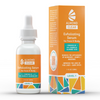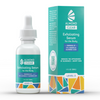The Benefits of Mandelic Acid for Your Skin and How to Use
Mandelic acid offers a variety of benefits for your skin, from exfoliation and acne control to brightening and anti-aging effects. But how exactly does mandelic acid work its magic, and how can you incorporate it into your skincare regimen for optimal results? Let’s talk about it!
What is Mandelic Acid?
Mandelic acid is a type of alpha hydroxy acid (AHA) derived from bitter almonds. As a natural ingredient, mandelic acid offers several benefits for skincare, including gentle exfoliation, anti-inflammatory and anti-fungal properties and skin brightening. Its molecular structure is larger compared to other AHAs like glycolic acid, making it less irritating and suitable for sensitive skin types.
Mandelic acid works by accelerating cell turnover, which helps to unclog pores, reduce acne, and improve overall skin texture and tone. For a more in-depth look of mandelic acid and its skincare benefits, you can read this previous article.
Benefits of Mandelic Acid for Your Skin
Mandelic acid offers a range of benefits for :
Exfoliation and Cell Turnover
Mandelic acid functions as a chemical exfoliant by breaking down the bonds between dead skin cells, allowing them to be shed more easily. This process helps to unclog pores, prevent congestion, and reveal smoother skin.
Additionally, mandelic acid promotes cell turnover by accelerating the production of new skin cells, which contributes to a brighter and more youthful complexion. Consistent use of mandelic acid can lead to healthier skin renewal and can diminish the appearance of dullness or rough texture.
Acne Reduction
One of the key benefits of mandelic acid is its ability to penetrate pores deeply and effectively. It helps to dissolve excess oil and debris, reducing the likelihood of pore blockages that lead to breakouts. Its antibacterial properties also play a role in combating acne-causing bacteria like P. acnes, which can contribute to inflammation and blemishes. By keeping pores clear and minimizing sebum production, mandelic acid can reduce acne breakouts over time.
Anti-Aging Effects
Mandelic acid stimulates collagen production in the skin, a vital protein responsible for maintaining skin elasticity and firmness. Increased collagen production helps to minimize the appearance of fine lines and wrinkles, promoting a smoother and more youthful complexion.
Helps With Hyperpigmentation and Scars
Mandelic acid is effective in fading dark spots and hyperpigmentation through its exfoliating action. By accelerating the shedding of pigmented skin cells and promoting the growth of new cells, mandelic acid helps to even out skin tone and reduce discoloration caused by sun damage, melasma, or acne scars. Its gentle yet potent exfoliation can also also improve the appearance of post-acne scars, smoothing their texture and reducing their visibility over time.
Improves Uneven Skin Texture
The exfoliating properties of mandelic acid work to smooth out rough and uneven skin texture, leaving the skin feeling softer and more refined. By removing dead skin cells and promoting cell turnover, mandelic acid helps to diminish rough patches, bumps, and flakiness.
It is Gentle on Skin
Unlike some other AHAs such as glycolic acid, mandelic acid has a larger molecule size, making it more gentle on sensitive skin. This characteristic reduces the likelihood of irritation and inflammation.
Does Mandelic Acid Help With Body Odor?
Mandelic acid's antibacterial properties make it beneficial for reducing the bacteria on the skin that causes body odor. When used in deodorant formulations, mandelic acid can help neutralize odor-causing bacteria, providing long-lasting freshness without harsh chemicals or irritants.
Is Mandelic Acid Good for Rosacea?
Mandelic acid is generally considered to be a suitable option for individuals with rosacea-prone skin due to its gentle nature and anti-inflammatory properties. While AHAs like mandelic acid can help promote skin renewal and improve texture, it's important to treat rosacea by consulting with a dermatologist for personalized recommendations.
How Does Mandelic Acid Work?
Mandelic acid gently loosens the bonds that hold dead skin cells together on the surface of your skin. This process is called chemical exfoliation. When you apply mandelic acid to your skin, it penetrates into the top layer and starts breaking down the glue-like substance that keeps old, dull skin cells stuck together.
As a result, these dead cells can easily slough off, revealing newer, smoother skin underneath. This process helps to unclog pores, reduce roughness, and improve overall skin texture without causing irritation.
How’s Mandelic Acid Different from Other AHAs?
Mandelic acid stands out among other alpha hydroxy acids (AHAs) due to its larger molecular size compared to popular AHAs. This larger size allows mandelic acid to penetrate the skin more slowly and gently, making it less likely to cause irritation, especially for sensitive skin types.
Mandelic Acid vs Lactic Acid
Mandelic acid and lactic acid are both alpha hydroxy acids (AHAs) but differ in several aspects. Mandelic acid has a larger molecular size than lactic acid, which means it penetrates the skin more slowly and is generally gentler. Lactic acid, on the other hand, has a smaller molecule size and can penetrate more deeply, making it more effective for intense exfoliation that may not be suitable for those with sensitive skin.
Mandelic Acid vs Glycolic Acid
Compared to glycolic acid, mandelic acid also has a larger molecular structure, making it less likely to cause irritation and more suitable for sensitive skin types. Glycolic acid is smaller and penetrates the skin more deeply, which can lead to more intense exfoliation but may also increase the risk of irritation, especially for those with sensitive or reactive skin.
Mandelic Acid and Retinol - Can You Use Them Together?
Using mandelic acid and retinol together in the same skincare routine is generally not recommended due to the potential for increased skin sensitivity and irritation. Both mandelic acid and retinol are active ingredients that promote cell turnover and exfoliation. Combining them can lead to excessive skin dryness, redness, and peeling, especially for those with sensitive skin.
We recommend using these ingredients on alternate nights or at different times of day to avoid overloading the skin and to introduce them gradually into your routine.
Who Can Use Mandelic Acid?
Mandelic acid is suitable for a wide range of skin types. It is beneficial for people with sensitive skin or dealing with acne, folliculitis, hyperpigmentation, fine lines, uneven skin tone, ingrown hairs or Keratosis pilaris. Its antibacterial properties help to target acne-causing bacteria, reduce inflammation, and prevent breakouts without drying out the skin excessively.
How Long Does It Take For Mandelic Acid To Work?
The timeline for experiencing noticeable improvements with mandelic acid can vary depending on the skin it is treating. For mild exfoliation and improved skin texture, you may begin to feel smoother and refined skin within a few weeks of regular use. Acne reduction and clearing skin concerns can typically take around 4 to 8 weeks of consistent application to see a noticeable difference.
How To Incorporate Mandelic Acid Into Your Skincare Routine
We recommend incorporating mandelic acid products into your skincare routine with these guidelines:
Patch Testing
Before applying a new product containing mandelic acid to your entire face, it's crucial to conduct a patch test. This involves applying a small amount of the product to a discreet area of your skin such as behind the ear or on the inner forearm. Over 24-48 hours moniton for any adverse reactions. Patch testing helps determine if you have any sensitivity or allergic reactions to mandelic acid.
Start With Lower Percentages
For those new to mandelic acid, it's recommended to start with lower concentrations to minimize the risk of irritation. Gradually increase the concentration or frequency of use as your skin becomes accustomed to the product. This allows your skin to adapt to mandelic acid more comfortably and effectively.
Use Sunscreen
Mandelic acid can increase skin sensitivity to sunlight, making it important to apply sunscreen daily. Choose a broad-spectrum sunscreen with SPF 30 or higher and apply it every morning, even on cloudy days or when indoors. Sunscreen helps protect your skin from harmful UV rays and prevents potential sun damage or hyperpigmentation caused by increased sensitivity.
Don’t Mix With Other Exfoliators
Avoid combining mandelic acid with other exfoliating products like scrubs, AHAs, or BHAs at the same time to prevent over-exfoliation and potential skin irritation. Over-exfoliating can compromise your skin barrier and lead to increased sensitivity, redness, or dryness.
Can I Use Mandelic Acid Every Day?
The frequency of using mandelic acid depends on the strength of the product and your individual skin tolerance. It's best to start with 2-3 times per week and gradually increase frequency based on how your skin responds.
Cautions
When using mandelic acid, it's important to be aware of potential side effects, including dryness, redness, and increased sensitivity to sunlight. Mandelic acid is an exfoliating ingredient that can cause mild irritation, especially when first starting or using higher concentrations. To minimize these effects, start with lower concentrations, use sunscreen daily, and monitor your skin's response.
Final Thoughts
1. Mandelic acid is a versatile and effective skincare ingredient suitable for various skin types and concerns. It offers gentle exfoliation, acne-fighting properties, and benefits for improving skin texture, tone, and brightness.
2. When incorporating mandelic acid into your skincare routine, remember to start with patch testing, use lower concentrations initially, and always follow up with sunscreen during the day to protect your skin.
3. Avoid mixing mandelic acid with other strong exfoliants and monitor your skin's response to optimize results while minimizing potential side effects.
4. With consistent and mindful use, mandelic acid can help you achieve clearer, smoother, and healthier-looking skin over time.









